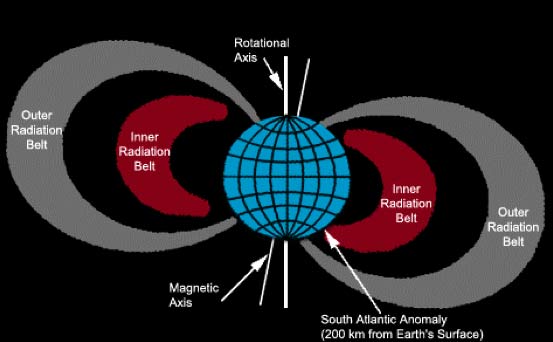Mysterious Radio Hiss Blamed on Space Weather

Weather that originates at the Sun, not here on Earth, is responsible for radio waves that cause an unusual shape of two belts of radiation that encircle Earth and contain "killer electrons" that can damage satellites and pose a risk to space travelers, scientists report.
It has been long known that low-frequency radio waves in space, known as plasmaspheric hiss, split the Van Allen radiation belts into two donuts of dangerous energetic electrons that travel at nearly the speed of light and are trapped in Earth's magnetic field.
Last year, NASA scientists reported evidence that lightning on Earth leaked radio waves into space and, after bouncing around in the magnetic field surrounding Earth, created the gap between the inner and outer radiation belts.
A team of scientists with the British Antarctic Survey, University of California and University of Iowa saw that they could test this theory by investigating whether there were more waves over Earth's continents than its oceans, because lightning occurs ten times more frequently over land than sea.
Data from the Combined Release and Radiation Effects Satellite (CRRES), launched in 1990 under the auspices of NASA and the U.S. Department of Defense, were used to measure the incidence of waves over continents versus ocean.
No relationship between the most intense waves at lower frequencies and the land masses was found. Instead these waves increase with the flow of the solar wind, which shoots electrons and other particles at Earth and throughout the solar system.
"Wave activity increases during geomagnetic disturbances driven by the Sun, suggesting that natural wave turbulence is responsible for the gap," said Nigel Meredith of the British Antarctic Survey, lead author of a research paper reporting the findings in the Journal of Geophysical Research.
Get the Space.com Newsletter
Breaking space news, the latest updates on rocket launches, skywatching events and more!
Plasmaspheric hiss consists of extremely low frequency radio waves with frequencies ranging from 100 Hz to several kHz. These waves scatter energetic electrons and divert some of them into the Earth's upper atmosphere, thereby creating the gap in the Van Allen radiation belts.
Fluxes of high-energy, or relativisitic, electrons which occur during space weather events such as coronal mass ejections and sunspot activity, are a risk to humans in space and damage spacecraft. Fluxes in the outer Van Allen radiation belt are particularly erratic and even the gap can be filled with killer electrons during intense solar weather events, such as the Halloween Storm in 2003, Meredith said.
A better understanding of solar weather and the source of plasmaspheric hiss will help scientists improve their forecasts of space conditions and make space travel safer for humans, he said.
"Understanding the source of hiss will help scientists produce the next generation of radiation belt models that will eventually be used for predictive purposes," Meredith told SPACE.com. "This will help humans in space plan their activities to avoid unnecessary exposure to extreme levels of radiation."
Explorer I, the first U.S. satellite, detected the Van Allen radiation belts in the late 1950s. The inner zone is relatively stable, while the outer zone is not. Jupiter, Saturn, Uranus and Neptune also have strong magnetic fields that trap high-speed electrons to create radiation belts.
The radiation belts were named for James Van Allen, who argued for a Geiger counter on Explorer I that detected the belts' charged particles. He died in August at aged 91.
- Sun's Next Stormy Cycle Starts
- James Van Allen's Last Science Paper
- Top 10 Strangest Things in Space
Join our Space Forums to keep talking space on the latest missions, night sky and more! And if you have a news tip, correction or comment, let us know at: community@space.com.

Robin Lloyd was a senior editor at Space.com and Live Science from 2007 to 2009. She holds a B.A. degree in sociology from Smith College and a Ph.D. and M.A. degree in sociology from the University of California at Santa Barbara. She is currently a freelance science writer based in New York City and a contributing editor at Scientific American, as well as an adjunct professor at New York University's Science, Health and Environmental Reporting Program.









